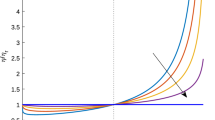Abstract
We examine a number of models that generate random fractals. The models are studied using the tools of computational complexity theory from the perspective of parallel computation. Diffusion-limited aggregation and several widely used algorithms for equilibrating the Ising model are shown to be highly sequential; it is unlikely they can be simulated efficiently in parallel. This is in contrast to Mandelbrot percolation, which can be simulated in constant parallel time. Our research helps shed light on the intrinsic complexity of these models relative to each other and to different growth processes that have been recently studied using complexity theory. In addition, the results may serve as a guide to simulation physics.
Similar content being viewed by others
References
C. H. Bennett, How to define complexity in physics, and why, inComplexity, Entropy and the Physics of Information, W. H. Zurek, ed. (Addison-Wesley, Reading, Massachusetts, 1990).
B. B. Mandelbrot,The Fractal Geometry of Nature (Freeman, San Francisco, 1983).
J. T. Chayes, L. Chayes, and R. Durrett, Connectivity properties of Mandelbrot's percolation process,Prob. Theory Related Fields 77:307 (1988).
T. A. Witten and L. M. Sander, Diffusion-limited aggregation, a kinetic critical phenomenon,Phys. Rev. Lett. 47:1400 (1981).
J. Machta, The computational complexity of pattern formation.J. Stat. Phys. 170:949 (1993).
J. Machta and R. Greenlaw, The parallel complexity of growth models,J. Stat. Phys. 77:755 (1994).
F. Barahona, On the computational complexity of Ising spin glass models,J. Phys. A: Math. Gen. 15:3241 (1982).
J. Machta, The computational complexity of the self-avoiding walk on random lattices,J. Phys. A: Math. Gen. 25:521 (1992).
J. C. Angles d'Auriac, M. Preissmann, and R. Rammal, The random field Ising model: Algorithmic complexity and phase transitions.J. Phys. (Paris)46:L173 (1985).
D. J. A. Welsh, The computational complexity of some classical problems from statistical physics, inDisorder in Physical Systems, G. R. Grimmett and D. J. A. Welsh, eds. (Oxford University Press, Oxford, 1990), p. 307.
M. Jerrum and A. Sinclair, Polynomial-time approximation algorithms for the Ising model,SIAM J. Computing 22(5):1087 (1993).
J. E. Hopcroft and J. D. Ullman,Introduction to Automata Theory, Languages, and Computation Addison-Wesley, Reading, Massachusetts, (1979).
H. R. Lewis and C. H. Papadimitriou,Elements of the Theory of Computation (Prentice-Hall, Englewood Cliffs, New Jersey, 1981).
R. Greenlaw, H. J. Hoover, and W. L. Ruzzo,Limits to Parallel Computation: P-Completeness Theory (Oxford University Press, Oxford, 1995).
D. S. Johnson, A catalog of complexity classes, inHandbook of Theoretical Computer Science, Volume A: Algorithms and Complexity, J. van Leeuwman, ed. (MIT Press/Elsevier, 1990), p. 68.
M. R. Garey and D. S. Johnson,Computers and Intractability: A Guide to the Theory of NP-Completeness (Freeman, New York, 1979).
A. V. Aho, J. E. Hopcroft, and J. D. Ullman,The Design and Analysis of Computer Algorithms (Addison-Wesley, Reading, Massachusetts, 1974).
F. E. Fich, The complexity of computation on the parallel random access machine, inSynthesis of Parallel Algorithms, J. H. Reif, ed. (Morgan Kaufman, San Mateo, California, 1993), Chapter 20, pp. 843–899.
R. M. Karp and V. Ramachandran, Parallel algorithms for shared-memory machines, inHandbook of Theoretical Computer Science, volume A: Algorithms and Complexity, Jan van Leeuwman, ed. (MIT Press/Elsevier, 1990), Chapter 17, pp. 869–941.
R. E. Ladner, The circuit value problem is log space complete for P,SIGACT News 7:18 (1975).
E. Fredkin and T. Toffoli, Conservative logic,Int. J. Theor. Phys. 21:219 (1982).
J. Von Neumann,Theory of Self-Reproducing Automata (University of Illinois Press, Urbana, 1966).
J. Machta, Y. S. Choi, A. Lucke, T. Schweizer, and L. V. Chayes. Invaded cluster algorithm for equilibrium critical points,Phys. Rev. Lett. 75:2792 (1995).
H. Venkateswaran, Circuit definitions of nondeterministic complexity classes,SIAM J. Computing 21:655 (1992).
J. Machta, Phase transitions in fractal porous media,Phys. Rev. Lett. 66:169 (1991).
J. T. Chayes, L. Chayes, and J. Machta, Phase diagram and correlation length bounds for Mandelbrot aerogels,J. Phys. A: Math. Gen. 26:4249 (1993).
L. Chayes and J. Machta, On the behavior of the surface tension for spin-systems in a correlated porous medium,J. Stat. Phys. 79:117 (1995).
U. Wolff, Collective Monte Carlo updating for spin systems,Phys. Rev. Lett. 62:361 (1989).
R. H. Swendsen and J.-S. Wang, Nonuniversal critical dynamics in Monte Carlo simulations,Phys. Rev. Lett. 58:86 (1987).
M. E. Fisher, The theory of condensation and the critical point,Physics 3:255 (1967).
C. M. Fortuin and P. M. Kasteleyn, On the random-cluster model,Physica 57:536 (1972).
A. Coniglio and W. Klein, Clusters and Ising critical droplets: A renormalisation group approach,J Phys. A: Math. Gen. 13:2775 (1980).
A. Gibbons and W. Rytter,Efficient Parallel Algorithms (Cambridge University Press, Cambridge, 1988).
L. A. Levin, Average case complete problems,SIAM J. Computing 15:285 (1986).
S. Ben-David, B. Chor, O. Goldreich, and M. Luby, On the theory of average case complexity,J. Computer Syst. Sc. 44:193 (1992).
Author information
Authors and Affiliations
Rights and permissions
About this article
Cite this article
Machta, J., Greenlaw, R. The computational complexity of generating random fractals. J Stat Phys 82, 1299–1326 (1996). https://doi.org/10.1007/BF02183384
Received:
Accepted:
Issue Date:
DOI: https://doi.org/10.1007/BF02183384




